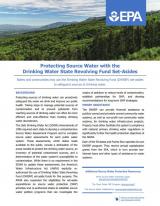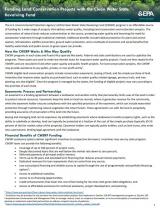Source Water Protection Funding
There are a variety of programs that can be used to provide funding to protect sources of drinking water at the local, state, and federal level. This page identifies useful resources for finding financial assistance tools to help communities build a patchwork of funding strategies to meet their environmental and public health protection goals.
On this page:
- EPA Funding Resources
- Other Federal Agency Resources
- Source Water Collaborative
- Investing in Source Water Protection
EPA Funding Resources
Drinking Water State Revolving Fund (DWSRF)
Funding for the Drinking Water State Revolving Fund (DWSRF) is provided annually through the Congressional appropriations process, and funds capitalize state loan banks to help maintain local drinking water infrastructure, like treatment plants and distribution systems. EPA then awards capitalization grants to each state for their DWSRF based upon the results of the most recent Drinking Water Infrastructure Needs Survey and Assessment. The state provides a 20 percent match.
States may use a portion of their capitalization grant from EPA as “set-asides” to help communities support water systems with non-infrastructure needs (such as building technical, managerial, and financial capacities of their water systems). States may use the set-asides to fund several types of source water protection activities, such as administering source water protection programs, providing technical assistance, and funding implementation activities. The American Water Infrastructure Act of 2018 expanded source water protection eligibilities under the DWSRF Program Local Assistance set-aside (often referred to as the 15% set-aside). Read the Expanded Source Water Protection Related Eligibilities under DWSRF's Local Assistance and Other State Program Set Aside memo.
Examples of activities that can be supported by set-asides include:
- Development (or update) of source water assessments;
- Development and implementation of source water protection plans;
- Land acquisition and conservation easements;
- Well abandonment;
- Utilizing cover crops and other best management practices;
- Building fences to protect water sources;
- Septic system surveys and replacement;
- Outreach and education; and
- Development of local ordinances to protect source waters.
Clean Water State Revolving Fund
Similar to the DWSRF, under the Clean Water State Revolving Fund (CWSRF) program, EPA awards grants to all 50 states plus Puerto Rico to support water infrastructure projects to fund a range of projects that address their highest priority water quality needs to achieve protections under the Clean Water Act. The states contribute an additional 20 percent to match the federal grants. EPA also provides direct grant funding for the District of Columbia, U.S. Virgin Islands, American Samoa, Guam, and the Commonwealth of Northern Marianas.
The CWSRF is primarily used for wastewater treatment infrastructure. However, there are also eligibilities related to source water protection, such as:
- Nonpoint source pollution management;
- Stormwater projects;
- Decentralized wastewater treatment systems (i.e. septic systems);
- Water conservation, efficiency, and reuse; and
- Watershed projects.
Find information about using eligibilities:
- EPA's Clean Water State Revolving Fund Webinar Series features professionals from around the country sharing their expertise on a range of topics related to the Clean Water State Revolving Fund
Clean Water Act Programs
The Clean Water Act (CWA) is the foundation for the protection of surface water quality in the United States.
- The 1987 amendments to CWA established the Section 319 Nonpoint Source Management Program, which addresses the need for greater federal leadership to help focus state and local nonpoint source efforts. Under Section 319, states, territories, and tribes receive grant money to support a wide variety of activities including technical and financial assistance, education, training, technology transfer, demonstration projects, and monitoring to assess the success of specific non-point source implementation projects.
- CWA also established the Water Quality Monitoring Grants program, authorizing EPA to provide financial assistance to states (including territories and the District of Columbia), eligible interstate agencies, and eligible tribes. EPA provides this financial assistance in the form of water pollution control (Section 106) grants. Section 106 grants provide funding to build and sustain effective water quality programs that ensure the health of our nation’s water bodies.
Financial and Technical Assistance for Water Utilities
- The Water Infrastructure and Resiliency Finance Center provides financial and technical assistance and advice to water utilities.
- Federal Funding for Water and Wastewater Utilities in Natural Disasters (Fed FUNDS) gives utilities information about federal disaster funding programs. Although Fed FUNDS focuses on major disasters, information can be used for any incident that disrupts water or wastewater services or damages critical infrastructure.
Environmental Finance Centers (EFCs)
Environmental Finance Centers (EFCs) partner with states, tribes, local governments, and the private sector to deliver targeted technical assistance providing innovative solutions to help manage the costs of environmental financing and program management.
Other Federal Agency Resources
Catalog of Federal and Domestic Assistance (CFDA)
The Catalog of Federal and Domestic Assistance (CFDA) is a compilation of assistance programs administered by federal agencies or state and local governments. You can search the assistance program listings for appropriate programs related to an issue like water quality protection or source water protection.
Find information about Federal Assistance Listings and the CFDA.
Top of Other Federal Agency Resources
Natural Resources Conservation Service (NRCS)
The 2018 Farm Bill, enacted on December 20, 2018, specifies that 10 percent of conservation funding through the Natural Resource Conservation Service (NRCS) - approximately $400 million per year - be targeted for source water protection. The Farm Bill supports conservation efforts of America’s farmers and ranchers through reauthorization and expanded flexibility of NRCS conservation programs. NRCS offers financial and technical assistance through conservation practices, activities, and enhancements to help agricultural producers make and maintain improvements on their land.
NRCS conservation program funds can provide technical and financial support for a wide range of on-the-ground conservation activities implemented by farmers, ranchers and forest landowners. These activities can include:
- Land management and improvement;
- Land restoration practices;
- Land rentals;
- Easements; and
- Development and adoption of innovative approaches and technologies for conservation
Learn more about leveraging NRCS Funding Opportunities and NRCS Conservation Programs to support Source Water Protection.
Top of Other Federal Agency Resources
Source Water Collaborative
Featured Topics on Source Water Protection Funding through the Learning Exchange
The Source Water Collaborative Learning ExchangeExitis an information sharing platform for discussing current challenges, sharing stories, and transferring knowledge on source water protection.
Using the drop-down menu, select featured topics on funding, such as:
- Funding for Source Water Protection: Resources for this topic include webinars, a resource document listing government and private grant opportunities, and case studies of partnerships to protect drinking water sources in Nebraska, Oregon, and New Hampshire.
- Source Water Protection Through Conservation Funding: Resources for this topic include webinars, examples of a successful RCPP pre-proposal and full proposal, and a map of RCPP protection processes.
Top of Source Water Collaborative
How to Collaborate Toolkit
The How to Collaborate ToolkitExitincludes resources on finding funding ideas, leveraging funding opportunities, and securing sustainable funding.
Top of Source Water Collaborative
Investing in Source Water Protection
Investing in watershed protection offers a promising and potentially cost-effective approach to securing safe drinking water. Follow this link to access reports, guidance, and tools on the economics and finance mechanisms underlying watershed investment programs, including resources on ecosystem services valuation, cost-benefit analysis, and natural infrastructure solutions.


